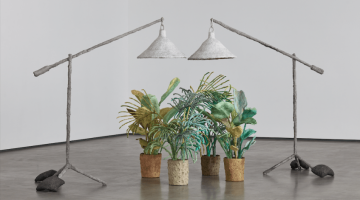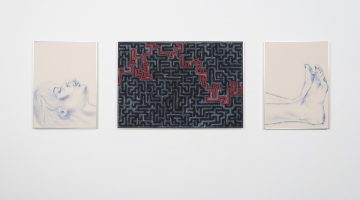By Chris Rusak
A recent exhibition at Christopher Grimes Gallery in Santa Monica, California, presented viewers with work that explicates the paths and pitfalls into which painters of the present propel. Although the show is now closed, a discussion of some of its merits (and missteps) is a worthy addition to the ever-morphing discourse on color and its ground, direction and emotion, and what makes for good contemporary painting.
San Francisco-based artist Joshua Podoll’s eight new works add to painting’s critical conversation, a conversation Los Angeles Times art critic Christopher Knight also joined in his review of the work, “Compositions in constant motion,” published August 19, 2013. Knight identifies the obvious parts of Podoll’s compositions: triangular forms as the main structural elements upon which all others rely; myriad texture results from varied paint application; a resulting push-pull tendency between planar depths, a fact which is no surprise since the artist gives homage in his titling to Hans Hoffman, a key proponent of this spatial phenomenon. Knight describes the artist’s implementation of this particular dynamic effect by saying that the work, “[grabs] a viewer by the lapels” and “drags your eye” around its visual routes. Indeed, anyone who takes pause and finds a suitable entrance to these freeways will enjoy a ride across its express lanes and a refill in its rest areas.
Yet, there is a particular emptiness to these paintings, experienced head-on, face-to-face — a point glossed over by the forgiving grace of digital photography. These are not necessarily open highways with the freedom of empty lanes and unlimited speed, rather intrastates quietly devoid of a passing traffic’s whizz or even the anxiety of a surreptitious trooper threatening trouble from the shoulder, offering little subjective scenery to pepper the journey. First, the shockingly bright white grounds of these canvases electroplate the stacked color fields and scream like a malfunctioning digital billboard, blinding drivers unnecessarily. Attenuating these works with a barely perceptible ground tint, or even the simple intervention of the gallery adjusting the wall color to ensure that hisses of dissonance are muted, would serve their overall effect well. This tendency to pump ocular intensity seems in fashion; take a look around and see the trend in Day-Glo hues making the rounds in galleries everywhere, a product, perhaps, of the electrified RGB internet diaspora on which eyes of the world fixate more and more. Yes, there are relaxed impasto patches and doses of grey finger-painted streaks, there are fields reminiscent of 1980s t-shirt appliqué acting as portals into planes beyond the ground; but, this pumped backlighting highlights a general emotional thinness in the material elements. Though Knight’s assessment is that this melange of “motifs in contemporary abstraction … are part refuse-heap of exhausted strategies and part newly invigorated construction,” they are just another artist’s cleaning out the fridge and producing a soup with weak, confused broth. Podoll’s work is a color-updated redressing of abstract expressionism at best, often failing to acknowledge its constraints, work on a rectangular plane that frequently feels imprisoned by its edges. While works from Podoll’s past — for instance A Welcome End to Knowing, a 2008 acrylic on canvas painting — take on the feeling of a Turrellian dreamscape, the new A Color That Does Not Exist emotes Cartoon Network-Delicious-graffiti pastiche. These highways lack spirit, they lack the pleasure of a windows-down, radio-up, driving-into-the-future thrill and instead rely only on the elements gathered from roadkill and collected from the map. How is this invigorated? Too much of these paintings feel like tossed-in-the-air luck with little vision.

Untitled (#09-13), Rebecca Morris, 2013
Courtesy Corbett vs. Dempsey
Perhaps this is the “style” of work being done today and Podoll just occupies another cabin in a long train of artists pushing the motifs of elements hanging on a scrim of wispy planar divisions and disparate patterned portals. Untitled (#09-13) (2013), by Rebecca Morris demonstrates these same undertakings in a less pure, less restrained color palette. Artist Tatiana Berg frequently throws down the wispy, spray-painted line in her work, but often to better effect, seen in her castered, hybrid painting/sculpture Black Swan Tent from 2011. Is Podoll merely another roadside attraction on the Provisional painting parkway, a loosely connected miasma of various artists’ work which looks hastily done, puerile, and usually like art school throw-away?
To Podoll’s credit, this body of work is at least united by its nature as a series of similar efforts; the ability to compare across canvases the qualities of line and gradations of color likely save it from the Provisional trashcan. Too, as Knight notes, the larger works hold a potential for something more enrapturing than the medium formats. Larger compositions (unified with small, study-like efforts) could also conceivably save the artist from the future obscurity of having created a body of work lacking a theme other than holding a torch for creating work which constantly strives to be different internal to the artist’s own practice — a risk Provisional artists au courant integrate each time they craft yet another soulless work, unidentifiable from the other haphazardly assembled compositions dripping out of the contemporary faucet. A few patches of appetizing impasto texture will not sustainingly redeem works from emotionally miserly patches of feathery pigment elsewhere. Nor can artists continue to rely on the blessings of internet imagery to carry viewers’ experiences to gratifying or inquisitive domains when the in concreto object is just another cool, botoxed clone from a pack of hip, confused painter-sheep.
The clarity that Knight speaks of here is crystalline, indeed: everyone else is doing it, it should work for me, too. Or, it all worked before, let’s try it again. But, like xeroxed copies of Reality TV, instances of painting such as these just hold up the commercial realities in between; the shows lack real emotion and instead sell contrived bravado and kindergarten-style tension. Yet, people tune in and watch and buy the advertised products. Maybe these are all the palliative for the aging Boomer and Nintendo generations longing for the days of an innocent, childhood playground romp. Maybe it’s just road grime stuck on the dashboard from driving down a populous road without vision, hitting each pothole exactly as the driver ahead, navigating it all the same for fear that a trooper might pick you out, alone, beside the crowd.
Chris Rusak is an artist working in Los Angeles.







